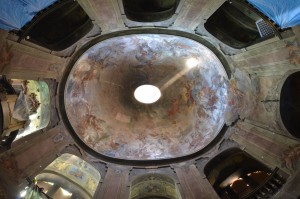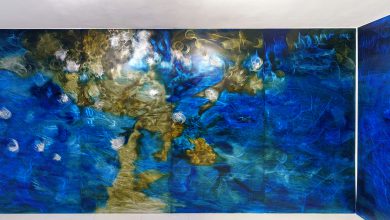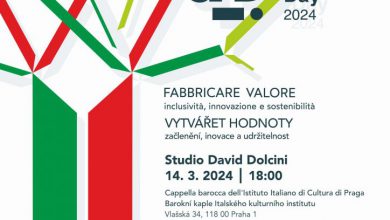
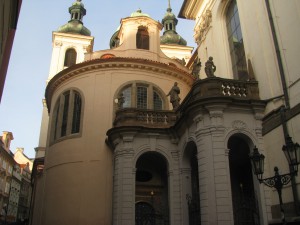 There is a precious stone embedded in that jewel of architecture and art, which is the Old Town of Prague; a construction that spans centuries and that has, embedded in every stone, the ante litteram “Made in Italy” mark, that is also, and above all, the symbol of an ancient bond between different cultures and testimony of a deep knowledge in the most advanced and refined initiatory-art techniques of construction. The Chapel of the Assumption of the Blessed Virgin Mary, part of the Clementinum architectural complex on Karlova Street, is better known as “Vlašská kaple”, or the Chapel of the Italians, as it has been called since July 23rd 1590, the day when the papal nuncio, Alfonso Visconti, laid the foundation stone of the building on the North-East side, as was commonly done in those days with particularly important buildings. Eager to have this place of worship were the members of the Congregation of the Blessed Virgin Mary of the Assumption, the Italian association founded by the Jesuits between 1573 and 1575, with the motto “Pro Deo et paupere”, which summed up its aim and purposes: to defend the Catholic faith in Protestant Bohemia and assist the poor and needy. As proof of how much the Italian Congregation was appreciated by the local people and its rulers – who granted them various privileges – is the fact that the Chapel, its material expression, was built on the most important street of the city that was named after Emperor
There is a precious stone embedded in that jewel of architecture and art, which is the Old Town of Prague; a construction that spans centuries and that has, embedded in every stone, the ante litteram “Made in Italy” mark, that is also, and above all, the symbol of an ancient bond between different cultures and testimony of a deep knowledge in the most advanced and refined initiatory-art techniques of construction. The Chapel of the Assumption of the Blessed Virgin Mary, part of the Clementinum architectural complex on Karlova Street, is better known as “Vlašská kaple”, or the Chapel of the Italians, as it has been called since July 23rd 1590, the day when the papal nuncio, Alfonso Visconti, laid the foundation stone of the building on the North-East side, as was commonly done in those days with particularly important buildings. Eager to have this place of worship were the members of the Congregation of the Blessed Virgin Mary of the Assumption, the Italian association founded by the Jesuits between 1573 and 1575, with the motto “Pro Deo et paupere”, which summed up its aim and purposes: to defend the Catholic faith in Protestant Bohemia and assist the poor and needy. As proof of how much the Italian Congregation was appreciated by the local people and its rulers – who granted them various privileges – is the fact that the Chapel, its material expression, was built on the most important street of the city that was named after Emperor  Charles IV, and that was the main part of the “Via Regia”, the “Královská cesta”, where ancient Czech kings used to go along on their way to their coronation on Hradčany hill. The construction was intended to replace the Italian Oratory chapel, the Community’s meeting place that had become too small due to the arrival of other Italians from their homeland. The new and bigger Chapel, that was intended to replace the previous one, was also used to host the religious functions of its members and was a tangible sign of the presence of the Catholic congregation on Protestant land.
Charles IV, and that was the main part of the “Via Regia”, the “Královská cesta”, where ancient Czech kings used to go along on their way to their coronation on Hradčany hill. The construction was intended to replace the Italian Oratory chapel, the Community’s meeting place that had become too small due to the arrival of other Italians from their homeland. The new and bigger Chapel, that was intended to replace the previous one, was also used to host the religious functions of its members and was a tangible sign of the presence of the Catholic congregation on Protestant land.
It took ten years to complete the Christian temple. Around 1594, thanks to donations received from members of the Congregation, the Chapel walls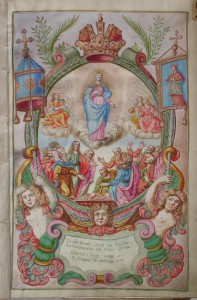 were decorated with frescoes, made by master painters who have remained anonymous, and the nave was enriched with altars. Then the vault was decorated with paintings and stucco work and the main altar was built. The building was embellished even more over the years and on August 9th 1600, Monsignor Filippo Spinelli, who was then papal nuncio at the court of Rudolf II, consecrated it to the Blessed Virgin Mary of the Assumption, with a solemn ceremony involving all the Italians living in the city, as well as the most important authorities in the Country. The Chapel, which was built according to Italian style, was surmounted by a dome and had an oval-shaped plan. It is interesting to note here that these elliptical-shape central plan churches were to become widespread, above all during the XVII and XVIII centuries and the Chapel of the Italians in the Old Town gained a significant place in the history of architecture, as it is considered the first example of an Italian oval plan chapel in Europe, north of the Alps. The small church was adorned with a majestic fresco of the Assumption of the Virgin, and later, in 1607, even the seven vaults were frescoed with scenes from the mysteries of the life of Mary. On solemn occasions the Divine Offices were celebrated in the Chapel, and since 1621, every 15th of August – during the celebrations of the Virgin – they would publicly and solemnly proclaim the new leaders of the Italian Congregation. In 1647, the temple was enriched with a new and valuable piece of art work: a painting for the main altar, made by the Czech Baroque painter Karel Škréta who celebrated the Virgin Mary to whom both the congregation as well as the place of worship were consecrated.
were decorated with frescoes, made by master painters who have remained anonymous, and the nave was enriched with altars. Then the vault was decorated with paintings and stucco work and the main altar was built. The building was embellished even more over the years and on August 9th 1600, Monsignor Filippo Spinelli, who was then papal nuncio at the court of Rudolf II, consecrated it to the Blessed Virgin Mary of the Assumption, with a solemn ceremony involving all the Italians living in the city, as well as the most important authorities in the Country. The Chapel, which was built according to Italian style, was surmounted by a dome and had an oval-shaped plan. It is interesting to note here that these elliptical-shape central plan churches were to become widespread, above all during the XVII and XVIII centuries and the Chapel of the Italians in the Old Town gained a significant place in the history of architecture, as it is considered the first example of an Italian oval plan chapel in Europe, north of the Alps. The small church was adorned with a majestic fresco of the Assumption of the Virgin, and later, in 1607, even the seven vaults were frescoed with scenes from the mysteries of the life of Mary. On solemn occasions the Divine Offices were celebrated in the Chapel, and since 1621, every 15th of August – during the celebrations of the Virgin – they would publicly and solemnly proclaim the new leaders of the Italian Congregation. In 1647, the temple was enriched with a new and valuable piece of art work: a painting for the main altar, made by the Czech Baroque painter Karel Škréta who celebrated the Virgin Mary to whom both the congregation as well as the place of worship were consecrated.
 Vlašská kaple was and still is an example of the ancient wisdom, mentioned by Vitruvius, who fused together art, science and architecture and conceal in the architectural elements and decorations, the secrets of harmony, known only to the enlightened artists and master architects of all times. One of these, for example, is the use of the number 7. Seven, in fact, were the frescoed vaults of the Chapel with the seven joys and sorrows of the Virgin, a number that, not coincidentally, according to religious tradition is the symbol of perfection and the ultimate expression of mediation between the human and the divine. But, even its position to the East – the place where the Sun rises, and its collocation on the East-West axis of the city, including the position of the entrances and its oval plan – an ancient symbol of the cosmic egg from which the whole universe derives, and sacred in ancient Egypt as well as in Alchemy – are all elements which, from a distant past, still convey a clear message: the desire to achieve, by means of a material creation, the highest level of spirituality.
Vlašská kaple was and still is an example of the ancient wisdom, mentioned by Vitruvius, who fused together art, science and architecture and conceal in the architectural elements and decorations, the secrets of harmony, known only to the enlightened artists and master architects of all times. One of these, for example, is the use of the number 7. Seven, in fact, were the frescoed vaults of the Chapel with the seven joys and sorrows of the Virgin, a number that, not coincidentally, according to religious tradition is the symbol of perfection and the ultimate expression of mediation between the human and the divine. But, even its position to the East – the place where the Sun rises, and its collocation on the East-West axis of the city, including the position of the entrances and its oval plan – an ancient symbol of the cosmic egg from which the whole universe derives, and sacred in ancient Egypt as well as in Alchemy – are all elements which, from a distant past, still convey a clear message: the desire to achieve, by means of a material creation, the highest level of spirituality.
But this symbol of the Prague Italians went through difficult times. It was damaged during the Thirty Years War in 1648 and during the two centuries after its construction, it was subject to several modifications, constant work interventions and maintenance of its spaces, due to various factors such as the frequent floods. In 1789, it went through a period of great decline following the decree of Emperor Joseph II, who suppressed the Hospital of the Congregation – headquarters of the Italian Cultural Institute in Prague – and had its property expropriated by the State. In this awkward situation, even the chapel’s furnishings had to be sold by the Congregation in order to cover the restoration costs, but already since 1783, following once again the orders of Joseph II, the divine offices in the Italian place of worship were almost totally suppressed. However, the Chapel continued to host meetings of the Congregation and remained a place where the Italians could come together, especially when in difficulty. In 1873, after three-hundred years since the foundation of the Congregation, the building – which was officially the property of the “Italian nation” since 1810 – was then restored by the architect Joseph Schulz, thanks to donations from the community.
factors such as the frequent floods. In 1789, it went through a period of great decline following the decree of Emperor Joseph II, who suppressed the Hospital of the Congregation – headquarters of the Italian Cultural Institute in Prague – and had its property expropriated by the State. In this awkward situation, even the chapel’s furnishings had to be sold by the Congregation in order to cover the restoration costs, but already since 1783, following once again the orders of Joseph II, the divine offices in the Italian place of worship were almost totally suppressed. However, the Chapel continued to host meetings of the Congregation and remained a place where the Italians could come together, especially when in difficulty. In 1873, after three-hundred years since the foundation of the Congregation, the building – which was officially the property of the “Italian nation” since 1810 – was then restored by the architect Joseph Schulz, thanks to donations from the community.
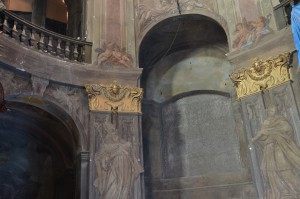 On June 7th, 1942, during World War II, the Congregation sanctioned the change of property of both the former Hospital Chapel in Malá Strana, as well as the Chapel of the Old Town in favour of the Italian State. Since then the building went through a new period of decline due to scarcity of economic resources, necessary for its restoration, but was also because of the historical events that affected Czechoslovakia. Since the beginning of the year 2000, the Italian institutions and community in the Czech Republic have shown greater concern and interest in the chapel, and new plans are being taken into consideration for its possible restoration – to bring back the building, a symbol of Italy, to its former glory.
On June 7th, 1942, during World War II, the Congregation sanctioned the change of property of both the former Hospital Chapel in Malá Strana, as well as the Chapel of the Old Town in favour of the Italian State. Since then the building went through a new period of decline due to scarcity of economic resources, necessary for its restoration, but was also because of the historical events that affected Czechoslovakia. Since the beginning of the year 2000, the Italian institutions and community in the Czech Republic have shown greater concern and interest in the chapel, and new plans are being taken into consideration for its possible restoration – to bring back the building, a symbol of Italy, to its former glory.
The Chapel of the Italians in the Old Town has been, for over four centuries, not only a symbol of the Italian presence in Bohemia and of the influence that Italian artistic genius had in this Country but is, above all, a tangible sign of fraternity between the two populations that, besides their cultural background, origin and differences, they have traced together their history and destiny in the ancient heart of Europe.
by Mauro Ruggiero
from the original: http://www.progetto.cz/una-gemma-preziosa-nel-cuore-di-praga/?lang=en
